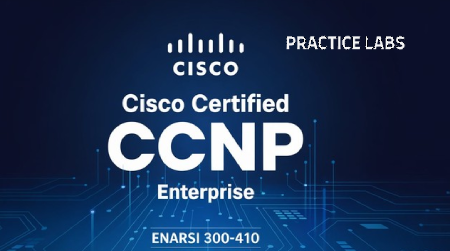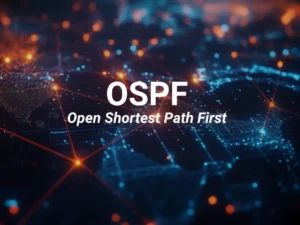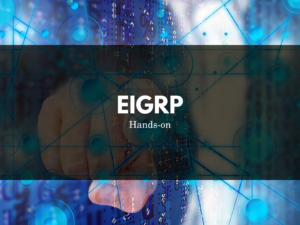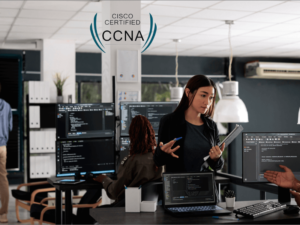CCNP ENARSI Labs
- Description
- Curriculum
- Reviews
Master CCNP ENARSI with Confidence!
Embark on a guided learning path crafted for your CCNP ENARSI certification success! Our hands-on labs, powered by EVE-NG emulation, immerse you in realistic network scenarios, helping you master advanced routing, services, and troubleshooting concepts. Pass the 300-410 ENARSI exam with ease and gain practical skills to design, deploy, and optimize production networks like a pro.
-
1Lab 1 - Objectives and BackgroundText lesson
In this lab, you will configure and examine EIGRP in two forms, Classic EIGRP and Named EIGRP. Named EIGRP is an update to Classic EIGRP that added multiprotocol support and default support for wide metrics.
-
2Part 1.1: Configure Basic Device SettingsText lesson
In Part 1, you will set up the network topology and configure basic settings on routers.
-
3Part 1.2: Configure and Verify EIGRP for IPv4Text lesson
Configure EIGRP with Autonomous System 27. R1 and R3 use Named EIGRP; R2 uses Classic EIGRP.
-
4Part 1.3: Tune EIGRP for IPv4Text lesson
In this part of the lab, you will tune and optimize EIGRP for IPv4 through the use of passive interfaces, authentication, and variance.
-
5Lab2 - Objectives and BackgroundText lesson
Customizing EIGRP operations can enhance network performance by speeding up convergence and stabilizing operations during outages. This lab explores advanced EIGRP techniques to optimize performance
in an enterprise network. -
6Part 2.1: Configure Basic Device SettingsText lesson
-
7Part 2.2: Implement EIGRP for IPv4Text lesson
-
8Part 2.3: Implement Advanced FeaturesText lesson
-
9Lab 3 - Objectives and BackgroundText lesson
In this lab, you will configure the network with EIGRP for IPv6. You will also configure passive interfaces, propagate a default route, configure a summary route, implement routing protocol authentication, modify load balancing, and filter routes with a prefix list.
-
10Part 3.1: Build the Network and Configure Basic Device SettingsText lesson
In Part 1, you will set up the network topology and configure basic settings and interface addressing on routers.
-
11Part 3.2: Implement EIGRP for IPv6 and Named EIGRPText lesson
In this part of the lab, you will configure and verify EIGRP in the network. Routers R1 and R3 will used Named EIGRP, while router R2 will use Classic EIGRP. After you have established the network, you will examine the differences in how each version of EIGRP deals with metrics.
-
12Part 3.3: Tune and Optimize EIGRP for IPv6Text lesson
In this part of the lab, you will tune and optimize EIGRP for IPv6 through the use of passive interfaces, default router redistribution, summary routes, authentication, load balancing, and route filtering.
-
13Lab 4 - Objectives and BackgroundText lesson
In this lab, you will configure single-area OSPF version 2 for IPv4 on a multiaccess Ethernet LAN. This lab was specifically designed to use two Layer 3 switches instead of three routers to highlight how a Layer 3 switch can also be used to provide routing services.
-
14Part 4.1: Configure Basic Device Settings and Interface AddressingText lesson
In Part 1, you will set up the network topology and configure basic settings and interface addressing on the router and Layer 3 switches.
-
15Part 4.2: Configure Single-Area OSPFv2Text lesson
In this part, you will implement single-area OSPF on a multiaccess Ethernet network.
-
16Part 4.3: Configure and Verify the Advertising of a Default RouteText lesson
In this part, you will configure a default static route to the internet on R1. R1 will then propagate the default route to other OSPF routers as an external Type 2 OSPF route (i.e., O*E2).
-
17Part 4.4: Implement OSPF Network Optimizing FeaturesText lesson
In this part, you will configure OSPF optimizing features including; Passive interfaces, Link costs, Reference bandwidth, Hello and Dead interval timers.
-
18Part 4.5: DR and BDR PlacementText lesson
In this part, you will configure OSPF DR and BDR placement on the multiaccess network.
-
19La5 - Objectives and BackgroundText lesson
In this lab you will configure multiarea OSPF version 2 for IPv4
-
20Part 5.1: Build the Network and Configure Basic Device SettingsText lesson
In Part 1, you will set up the network topology and configure basic settings and interface addressing on the routers and Layer 3 switches.
-
21Part 5.2: Configure Multiarea OSPFv2Text lesson
In this part, you will implement multiarea OSPF. Multiarea OSPF defines a two-layer area hierarchy using a backbone area interconnecting regular areas.
-
22Part 5.3: Exploring Link State AnnouncementsText lesson
In this part, you will verify that the network has converged and explore how link-state advertisements (LSAs) are used as the building blocks for the OSPF link-state database (LSDB).
-
23Lab 6 - Objectives and BackgroundText lesson
In this lab, you will configure route summarization and route filtering using Prefix-lists, ACLs, Distribute list in a multiarea OSPF network.
-
24Part 6.1: Basic Device Settings and RoutingText lesson
In Part 1, you will set up the network topology and configure basic settings and interface addressing on the router and Layer 3 switches
-
25Part 6.2: OSPFv2 Route SummarizationText lesson
To reduce the size of the routing table and LSDB, network prefixes must be summarized. Route summarization improves OSPF performance as fewer network entries are required.
-
26Part 6.3: OSPFv2 Route FilteringText lesson
In this part, you will learn about OSPF route filtering. Route filtering is a method for selectively identifying routes that are advertised or received from neighbor routers. Route filtering may be used to manipulate traffic flows, reduce memory utilization, or improve security.
-
27Lab 7 - Objectives and BackgroundText lesson
In this lab, you will configure the network with multiarea OSPFv3 routing using the AF feature for both IPv4 and IPv6 in OSPF areas 0, 1 and 2.
-
28Part 7.1: Device Settings and Interface AddressingText lesson
In Part 1, you will set up the network topology and configure basic settings and interface addressing on routers and switches.
-
29Part 7.2: Configure Traditional OSPFv3 for IPv6 on D1Text lesson
In this part of the lab, you will configure traditional OSPFv3 for routing IPv6 on D1, which is in the IPv6-only area.
-
30Part 7.3: Configure OSPFv3 for AF IPv4 and AF IPv6Text lesson
In this section you will configure OSPFv3 with AF for the IPv4 and IPv6 address families on R1, R2, R3, D1 and D2.
-
31Part 7.4: Verify OSPFv3Text lesson
In this part of the lab you can verify neighbor adjacencies with traditional OSPFv3 and OSPFv3 with AF commands.
-
32Part 7.5: Tune OSPFv3Text lesson
In this part you will configure the passive interface with passive-interface command in OSPFv3 router mode
-
33Lab 8 - Objectives and BackgroundText lesson
In this lab you will configure eBGP for IPv4
-
34Part 8.1: Configure Device Settings and Interface AddressingText lesson
In Part 1, you will set up the network topology and configure basic settings and interface addressing on routers
-
35Part 8.2: Configure and Verify eBGP for IPv4 on all RoutersText lesson
In this part you wil configure and verify eBGP for IPv4
-
36Part 8.3: Configure and Verify Route Summarization and Atomic AggregateText lesson
In this part, you will configure and verify route Summarization
-
37Part 8.4: Configure and Verify Route Summarization with Atomic Aggregate and AS-SetText lesson
Configure route summarization using atomic aggregate and AS-Set
-
38Part 8.5: Configure and Verify the Advertising of a Default RouteText lesson
In this part, you will configure and advertise default route via BGP

Why Choose Our Learning Path?
-
Interactive Labs: Build and troubleshoot networks with Cisco devices in EVE-NG’s cutting-edge emulation environment.
-
Expert Guidance: Follow step-by-step tutorials designed by certified professionals to ensure exam readiness.
-
Real-World Skills: Apply advanced routing protocols (OSPF, BGP), VPNs, and automation techniques in production-grade scenarios.
EVE-NG setups (advanced users):
VMware Workstation/ESXi or VirtualBox for running EVE-NG.
16+ vCPUs, 64GB+ RAM, 200GB SSD for hosting labs.
Cisco IOS/IOS-XE images (legally sourced, e.g., via Cisco VIRL or partner programs).
-
Network Administrators and Engineers:
-
Professionals managing enterprise networks who want to deepen their skills in advanced routing protocols (e.g., OSPF, BGP, EIGRP), IP services, and network troubleshooting.
-
-
Aspiring CCNP Enterprise Certificants:
-
IT professionals pursuing the CCNP Enterprise certification, specifically the 300-410 ENARSI exam, to validate advanced technical skills.
-
Individuals who have completed or are familiar with CCNP Core (350-401 ENCOR) and want to specialize in routing and services.
-







